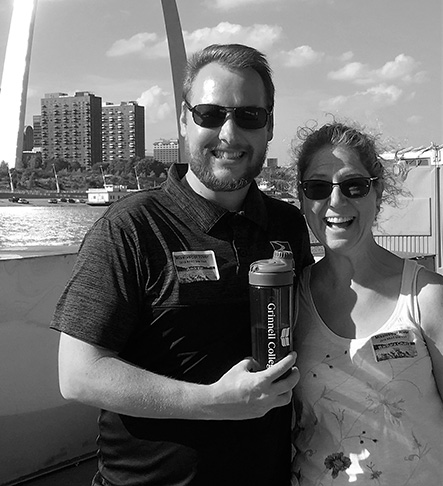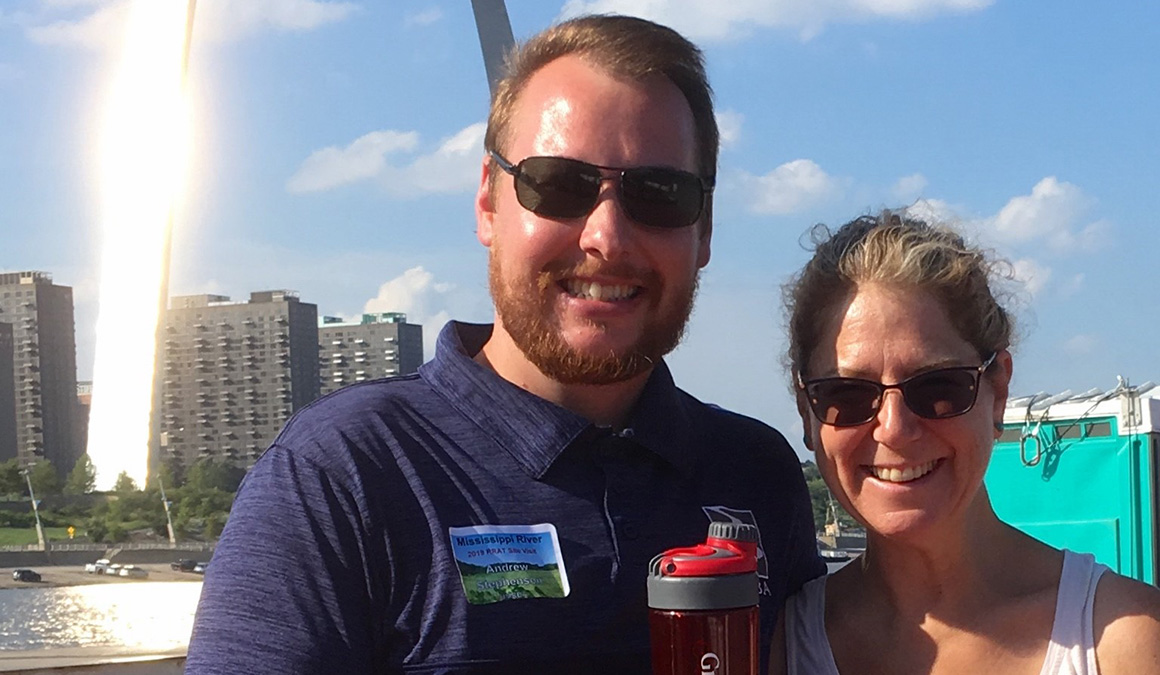Barbara Charry ’85 and Andrew Stephenson ’10
Grinnell alumni preserve river ecosystems through restoration efforts.

Barbara Charry ’85 and Andrew Stephenson ’10 use nature-based solutions to protect river wildlife and address climate change.
Barbara Charry ’85 and Andrew Stephenson’s ’10 passion for river restoration is rooted in their experiences at Grinnell College.
Charry’s journey began with biology professor Kenneth Christiansen’s sociobiology class.
“I didn’t realize you could study the behavior of animals,” says Charry. “After that class, I did an independent study where I gave 30-minute presentations in Des Moines classrooms with small animals from the Blank Park Zoo. Even though I had an English degree, I knew leaving Grinnell that I wanted to work with wildlife.”
For Stephenson, it began with his first-year tutorial taught by anthropology professor Vicki Bentley-Condit, Human: What Is and What Is Not?
“I became interested in primatology,” Stephenson explains. “At Grinnell, I studied Japanese macaques’ social hierarchies at the Blank Park Zoo, and I did an independent study investigating chimpanzees and their interactions with humans in Senegal during my study abroad. After Senegal, I became interested in how humans and natural resources interact, and that interest led me to my work with the Upper Mississippi River Basin Association.”
Now, Charry and Stephenson protect wildlife through their work on the Missouri and Mississippi Rivers.
In 2019, Atchison County in northwestern Missouri experienced extreme flooding across 56,000 acres for over 200 days.
Missouri River levee L-536, one of three within Atchison County, was breached in seven locations alone. To address the levee’s damage, the Atchison County Levee District board recruited Charry to help them make a levee setback feasible.
As the floodplains and nature-based solutions strategy manager for The Nature Conservancy in Missouri, Charry works to protect biodiversity and combat climate change. “My team and I develop nature-based solutions that balance the needs of humans and wildlife with the need to be more resilient to future flood risks,” she says.
The levee board opted for a levee setback – relocating the damaged levee inland – to minimize future flood damage while addressing environmental concerns.
“I brought in relevant partners from state and federal agencies who have access to different programs, funding streams, and savvy solutions to help make this project feasible” says Charry.
The biggest hurdle of the project was real estate. “The location of the levee setback was on private land owned by farmers in the community,” Charry explains. “The levee board had the authority to simply take the land, but everyone unanimously agreed that the farmers who owned the land should be compensated so they could replace the land lost.”
Through the collaboration with The Nature Conservancy and the other partners such as the U.S. Army Corps of Engineers (USACE), USDA Natural Resources Conservation Service, and Missouri Emergency Management Agency, the Atchison County Levee District board secured compensation for the farmers’ land and proceeded with construction in August 2020. The new levee is now flood ready and will restore 1,300 acres of wildlife habitat.
Due to her regular collaboration with the U.S. Army Corps of Engineers, Charry had the opportunity to attend USACE’s River Resources Action Team’s annual barge conference, where she met Stephenson in 2019.
 Andrew Stephenson ’14, left, ran into Barbara Charry ’85 on a Mississippi River barge during a conference in St. Louis a few years ago.
Andrew Stephenson ’14, left, ran into Barbara Charry ’85 on a Mississippi River barge during a conference in St. Louis a few years ago.
“For the conference, we were on a barge that traveled from Hannibal, Missouri to St. Louis, as we heard presentations about the latest topics related to current river basin work,” Charry explains.
“It’s incredible to run into Grinnellians ‘in the wild,’” says Stephenson. “It helped that one of us had a Grinnell water bottle.”
Stephenson works as the policy and programs director for the Upper Mississippi River Basin Association (UMRBA). “The organization was created by the governors of Illinois, Iowa, Minnesota, Missouri, and Wisconsin to develop regional coordination in managing the Upper Mississippi River,” Stephenson says. “We help organize interaction and collaboration between state and federal agencies in their management and implementation of various river-related programs.”
In his position, Stephenson focuses on ecosystem and navigation-related work. Recently, he has worked predominantly in facilitating state-federal collaboration on the Upper Mississippi River Restoration (UMRR) program.
“The UMRR program reduces the effects of degradation in the Upper Mississippi River ecosystem through habitat rehabilitation projects and systemic monitoring and research,” says Stephenson. “The UMRR is coming up on its 35th anniversary, and it’s done a great deal of good for our river ecosystems. It has restored over 100,000 acres of habitat, and it’s projected to restore 65,000 more within the next decade.”
Stephenson and Charry both cite climate change as a major issue influencing current restoration efforts.
“Climate change is a huge issue for the river because we are going to see increased rainfall and wetter years here in the Midwest,” explains Stephenson. “Our floodplain forests are going to experience tree loss because while the trees have adapted to long-standing water, they cannot handle the sustained flooding that we are witnessing.” Charry agrees that the nature of flooding is changing, noting that floods are becoming more frequent and are lasting longer.
“We need to develop new solutions to tackle these problems,” she says. “Nature-based solutions through river restoration that balance the needs of humans and wildlife are the key to preparing ourselves for flooding in the future.”
“The rivers are a vital resource for the Midwest,” Stephenson adds. “Not only are they a part of our history, but they are also a place of recreation, a water source, an energy source, a trade route, and home to hundreds of wildlife species. We need to protect these essential, natural resources.”
Learn more about the how The Nature Conservancy and Upper Mississippi River Restoration program are approaching environmental restoration and other Earth-friendly initiatives.
— by Leila Payer ’21
Grinnellians know life is much bigger than a job; it’s about leading a life of meaning and purpose. Attorney Jillian Kong-Sivert ’91 helps immigrants navigate a challenging legal system while Matheos Mesfin’s ’14 transformative experience at Grinnell led him to create the Institute for East African Councils on Higher Education.